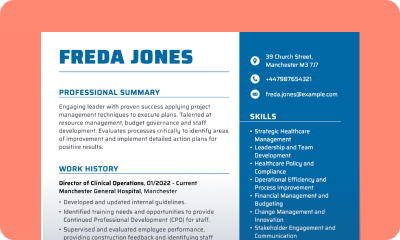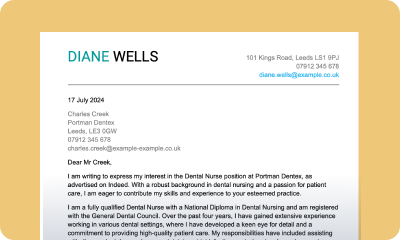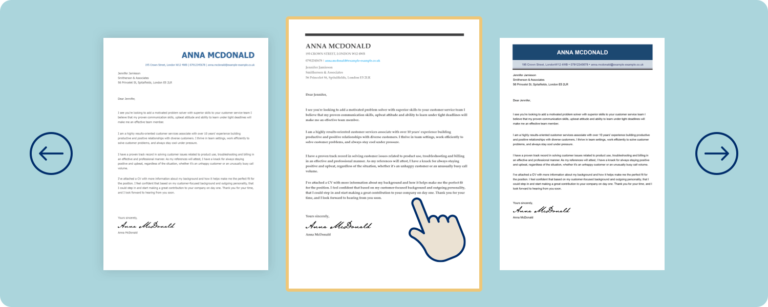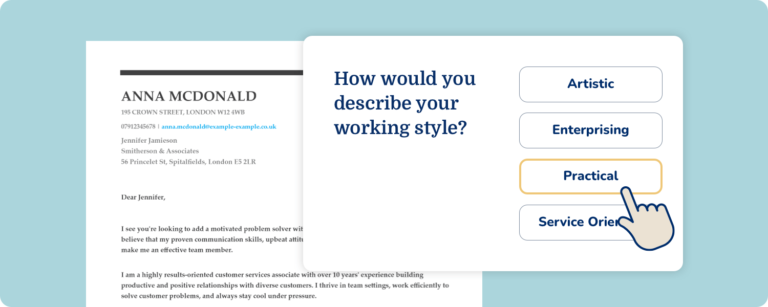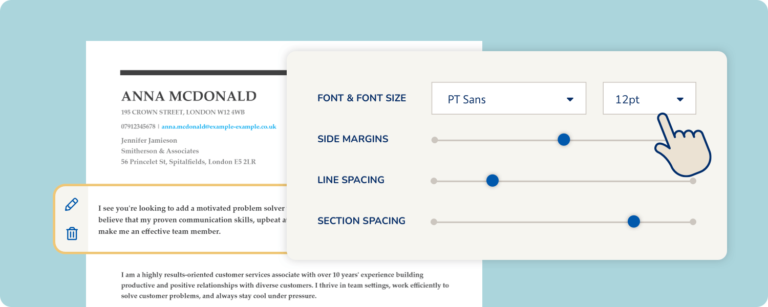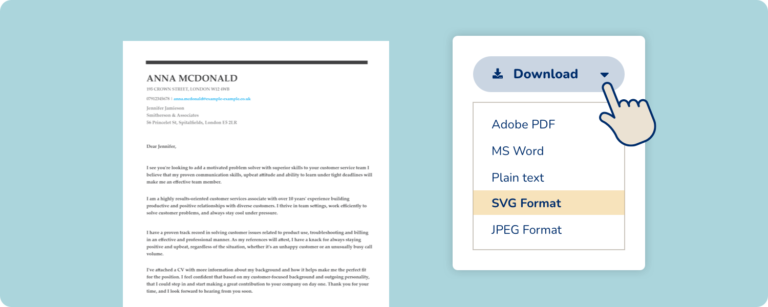- Our customers have been hired by : * Foot Note
Design a Cover Letter online
You don’t have to write your cover letter from scratch to get your dream job. All you need to do is use our Cover Letter generator. You’ll get a professional Covering Letter tailored to your requirements, industry and position.
Answer few simple questions and our cover letter maker will do the rest, putting you in pole position for the job application. Get started today!
Build your Cover letter online
Did you know that one of the most common methods of creating cover letters nowadays is using AI to write Cover Letter samples? There is however a downside to this solution. AI is a new technology, so many of us still struggle to use its full potential. Besides, it can provide you with just a raw text to copy but what about the format?
This is where our AI-supported builder with cover letter templates comes in handy. Using a professional template allows you to easily prepare a flawless letter that will meet the standards of your new potential employer. Check how easy it is with our cover letter creator in just a few simple steps!
Start building your cover letter by adding your name and selecting one of the many available templates. Choose from a variety of classic or modern formats.
In the second step, fill in some basic information to tailor the cover letter to your individual needs. From a ready-made list of skills and qualities required for the position, select the ones that apply to you. Adapt the letter to your working style by choosing from the 6 available options.
Now you can further personalise your letter by clicking on each individual section. You can also add or remove sections. At any time during editing, you also have the possibility to change both the letter template and its type, adjust fonts and spacing between sections.
Benefits of using our cover letter builder
Unique
You gain access to over a dozen unique cover letter templates that you can freely personalise. Choose from a variety of modern or classic templates. You can be sure that your letter will not be a cookie-cutter formula, but a tailor-made, professional cover letter with an original layout.
Intuitive
Our builder was developed in collaboration with recruiters and employment specialists. It will guide you step by step through the creation process so that your letter contains all the required information set out in a clear and accessible format.
Reliable
Our Cover Letter Maker has been developed in collaboration with experienced recruiters and employment specialists. It will assist you in writing a letter for a specific profession. For example, it will tell you what skills and qualities may be useful for a given position. Plus, it contains ready-made content sections that will make the whole process a lot easier!
Foolproof
Writing may not be one of your strengths. Don’t worry! With our cover letter builder, you will create a grammatically correct, well-structured document. Additionally, the cover letter creator has a built-in spell checker!
Accessible
You can easily save and download your file in any format. Plus, you can always go back to your letter to edit it and re-download it as you wish.
FAQs: Frequently asked questions
How do I design my own Cover Letter?
If you want to create a Covering Letter from scratch, make sure to include some key elements:
- your name and contact details
- contact details of the company you are applying to
- a formal greeting and introduction
- the main part, often referred to as the sales pitch
- a professional conclusion.
Where can I make a free Cover Letter?
You can find a free sample Cover Letter ready to download on our Cover Letter Templates page.
How do I turn my CV into a Cover Letter?
Your Curriculum Vitae (CV) already contains the most important information you need for your Covering Letter. Now you just need to put it into words and present it in an appealing way.
In addition, if you want to create a coherent CV + Cover Letter duo, use a similar layout, the same font and colours.
PS. We can help you create your CV too!
Is it OK to use a cover letter builder?
Yes, absolutely! Many people decide to take this step to make sure they get a professional, flawless cover letter that complies with current standards.
Just remember to choose a builder approved by recruiters – such as ours!
How do I create a covering letter?
You have three options:
- You can write it from scratch according to the current standards. This is the most difficult and time-consuming method.
- Choose a cover letter template.
The template makes it easy to write, inspires you and ensures that you do not forget any of the necessary sections. - Use our Cover Letter creator. This is the most recommended and easiest method. By using a professional cover letter generator developed in cooperation with recruiters, you can be sure that your letter will meet all requirements.
Can you pay someone to write your cover letter?
Yes, you can. Especially if you’re not an expert writer, outsourcing the creation of a professional letter to a professional can be a good step. Our specialists work with employment experts to create customised cover letters tailored to your needs.
How to build a cover letter?
- Start by writing headlines containing your contact details.
- Then open your letter with a formal greeting, for example Dear Hiring Professional.
- In the introduction, briefly state why you are interested in the offer.
- Next, in the body of the letter, convince the recruiter that you are the right candidate for the position. Present your skills and accomplishments that might be relevant for the job.
- Conclude the letter by indicating your readiness to work and willingness to meet for an interview.
- Remember that your letter should fit on one page.
Build a successful Cover Letter!
Writing a cover letter from scratch is not easy. You need to pay attention to a lot of details, include the right elements, use keywords specific to your profession, apply the right letter format and at the same time make sure that it is well constructed and written in correct English.
Don’t risk any mistakes – choose our recruiter-approved Cover Letter creator and get yourself a professional letter tailored to your needs.
*The names and logos of the companies referred to above are all trademarks of their respective holders. Unless specifically stated otherwise, such references are not intended to imply any affiliation or association with myperfectCV.
